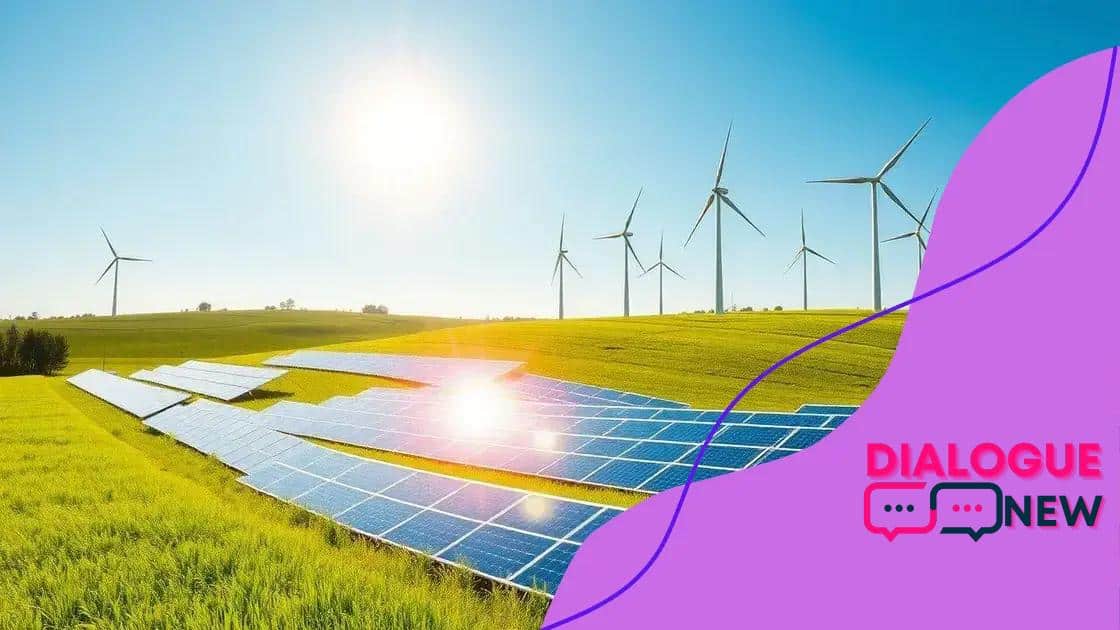Renewable energy incentives and subsidies: what you need to know

Renewable energy incentives and subsidies reduce installation costs and lower energy bills, making the transition to clean energy more affordable while promoting sustainability.
Renewable energy incentives and subsidies play a crucial role in making clean energy solutions more accessible. Have you ever wondered how these programs can benefit your investments and help the planet? Let’s dive into the details.
Understanding renewable energy incentives
Understanding renewable energy incentives is essential for anyone considering investments in clean energy. These incentives help offset the costs associated with switching to renewable sources, encouraging more people to participate in the green energy movement.
Many governments, both local and national, offer financial assistance designed to stimulate the growth of renewable energy. This support can come in various forms, such as tax credits, rebates, and grants. By taking advantage of these incentives, you can reduce your upfront costs significantly, making renewable energy more accessible.
Different types of incentives
There are several types of renewable energy incentives available:
- Tax credits: These allow you to reduce your tax liability based on your investment in renewable energy.
- Grants: Typically offered by government agencies, grants provide direct funding to help offset installation costs.
- Rebates: These are cash-back offers that reduce the price you pay for renewable energy systems.
Choosing the right combination of these incentives can maximize your savings and encourage sustainable practices. As you explore your options, keep in mind that eligibility requirements may vary. Researching local and federal programs will also help you make informed decisions.
How renewable energy incentives work
The goal of these incentives is simple: to promote the use of clean energy by making it more affordable. For instance, when you install solar panels on your home, you may qualify for a tax credit that reduces your overall tax bill. This means that you not only save on installation costs but also gain long-term savings through lower energy bills.
Many homeowners find that using alternative energy not only helps the environment but also leads to financial benefits over time. By lowering your dependency on fossil fuels, not only do you contribute to the planet’s health, but you can also protect yourself from fluctuating energy prices.
If you’re considering going green, start by determining which incentives you qualify for. This can make a significant difference in how quickly you can transition to renewable energy solutions. Be sure to consult with local organizations that specialize in renewable energy to get advice tailored to your specific situation.
Types of subsidies available
There are various types of subsidies available that can significantly ease the financial burden of investing in renewable energy. Understanding these options empowers you to make informed decisions about which systems will benefit you most.
Different programs might target homeowners, businesses, or even entire communities. Each type of subsidy has its own set of criteria, benefits, and application processes. Let’s look at some common subsidies available.
Tax credits
Tax credits are among the most popular forms of subsidies for renewable energy investment. They allow you to reduce the amount of tax you owe, making it easier to afford your system installation.
- Federal tax credits can cover a percentage of your installation costs, leading to significant savings.
- State tax credits may also be available, depending on your location and energy choices.
- In some areas, local governments offer additional tax incentives that can boost your savings.
Rebates
Rebates are another straightforward form of direct financial support. These cash-back offers can make a substantial impact on your overall investment.
- Utility companies frequently provide rebates for energy-efficient appliances and systems.
- Government programs also offer rebates for various renewable installations, helping to reduce your initial costs.
- These rebates can often be applied immediately, making the transition to renewable energy more attractive.
Understanding your eligibility for these programs can help you optimize your renewable energy solutions. As you explore renewable energy subsidies, it’s crucial to keep abreast of changing regulations and available programs to maximize your financial incentives. Researching and applying for these subsidies can greatly enhance your ability to invest in sustainable practices.
Investing in renewable energy is not only beneficial for your wallet but also for the environment. With the right subsidies in place, making the switch can be an attainable goal for many.
How to apply for energy incentives

Applying for energy incentives can seem overwhelming, but it doesn’t have to be. With a clear understanding of the process, you can navigate through the steps smoothly. First, it’s essential to identify the specific incentives available in your area. This varies by state and local government, so researching early ensures you find programs that suit your needs.
Most applications will require specific documentation to prove your eligibility. You may need to submit details such as your energy consumption, installation invoices, and proof of purchase for eligible equipment. Let’s break down the application process into manageable steps.
Step-by-step application process
1. **Research incentives:** Start by looking up local, state, and federal programs that offer energy incentives. Websites like the Database of State Incentives for Renewables & Efficiency (DSIRE) can help.
2. **Check eligibility:** Carefully read through the eligibility criteria for each program. Ensure that your home or business meets the necessary requirements to qualify.
3. **Gather documentation:** Prepare all documents you’ll need, such as installation receipts and tax documentation. Having everything organized from the beginning saves time and effort later.
4. **Complete the application:** Fill out the necessary forms provided by the incentive program. Be sure to double-check all information for accuracy before submitting.
Common requirements for applications
- Proof of purchase: Most programs require copies of receipts or invoices to confirm your investment in renewable energy.
- Energy audits: Some incentives may ask for a completed energy audit to assess your home’s efficiency.
- Installation details: Provide specifics on the equipment installed, including brand and model numbers.
After submitting your application, be prepared to wait for a response. Keep a record of your application details in case you need to follow up. Understanding the timelines and any potential delays can help manage expectations.
Many programs offer customer support to assist applicants with questions or concerns. Don’t hesitate to reach out if you need clarification on any aspects of the process. The benefits of applying for these incentives are well worth the effort!
Impact on your energy bills
The impact of renewable energy incentives on your energy bills can be significant. By switching to renewable sources like solar or wind power, you may notice a substantial decrease in your monthly energy costs.
Using renewable energy not only helps the environment but can also protect you from fluctuating energy prices. Here are some ways that these incentives can help improve your financial situation.
Immediate savings
With the help of government incentives, you can reduce the upfront costs of installing renewable energy systems. Many people find that the initial savings translate into lower bills right away.
- Tax credits: These can reduce your tax liability and make it easier to manage your finances.
- Rebates: Cash-back offers on installations can lower the initial investment needed.
- Net metering: If your system produces more energy than you use, you may be able to sell excess energy back to the grid, further reducing your bill.
Long-term benefits
Over time, the savings only increase. As energy prices rise, having your own renewable energy source makes you less dependent on traditional energy providers. Your stability improves, as you are less affected by price spikes.
Additionally, many renewable energy systems require less maintenance compared to traditional systems, leading to fewer unexpected costs. Because of the longevity of renewable technologies, you can expect many years of savings.
Investing in energy-efficient practices can also amplify these savings. By combining incentives with energy conservation, your overall expenses related to energy can truly decrease.
Understanding how renewable energy incentives affect your energy bills enables you to make informed choices about your energy use. It’s wise to analyze your current bills and compare them to potential savings after installing a renewable energy system. The benefits can be profound, leading to a healthier financial future.
Future trends in renewable energy funding
The future of renewable energy funding looks promising, with several trends emerging that can shape how individuals and businesses invest in clean energy. As technology advances and societal awareness grows, various funding sources are adapting to meet the demand for sustainable solutions.
Financial institutions are increasingly recognizing the benefits of supporting renewable energy projects. This shift leads to an influx of capital towards sustainable initiatives, which can significantly impact energy production.
Innovative financing models
New financing models are becoming popular, allowing more people to invest in renewable energy without needing vast amounts of upfront capital.
- Community solar projects: These enable individuals to invest in solar energy collectively, sharing both the costs and benefits.
- Green bonds: These specialized bonds fund environmentally friendly projects, providing investors with a way to contribute to sustainability.
- Power purchase agreements (PPAs): These contracts allow companies to buy electricity from renewable sources at a fixed price, offering financial stability and predictability.
Increased government support
Governments are expected to boost funding for renewable energy initiatives. This includes expanding tax credits and subsidies, which can greatly enhance affordability.
In some regions, policymakers are proposing legislative measures to support renewable energy infrastructure, ensuring consistent funding streams. This support may also lead to increased public-private partnerships aimed at developing new technologies and systems.
As demand for renewable energy grows, educational institutions may also provide specialized funding programs. By collaborating with universities, the renewable energy sector can attract talent and resources that focus on innovative solutions.
Advancements in technology will likely streamline the funding process, making it easier than ever for both investors and project developers to collaborate. With these trends on the rise, the future of renewable energy funding holds great potential for fostering sustainable growth.
renewable energy incentives can lead to significant financial benefits while promoting a sustainable future. From tax credits to rebates, there are various options available that can ease the transition to renewable energy sources. As more opportunities arise, staying informed will allow you to maximize your savings and impact. Embracing these incentives not only helps your wallet but also contributes to a healthier planet for everyone.
FAQ – Frequently Asked Questions About Renewable Energy Incentives
What are renewable energy incentives?
Renewable energy incentives are financial benefits, such as tax credits and rebates, that help reduce the cost of switching to clean energy sources.
How do I apply for energy incentives?
To apply for energy incentives, research available programs, check eligibility, gather necessary documents, and complete the application forms.
What types of subsidies are available for renewable energy?
Common subsidies include tax credits, rebates, and grants, each designed to lower the costs of renewable energy installations.
How can renewable energy incentives affect my energy bills?
By utilizing renewable energy incentives, you can significantly lower your installation costs and benefit from reduced monthly energy bills over time.





